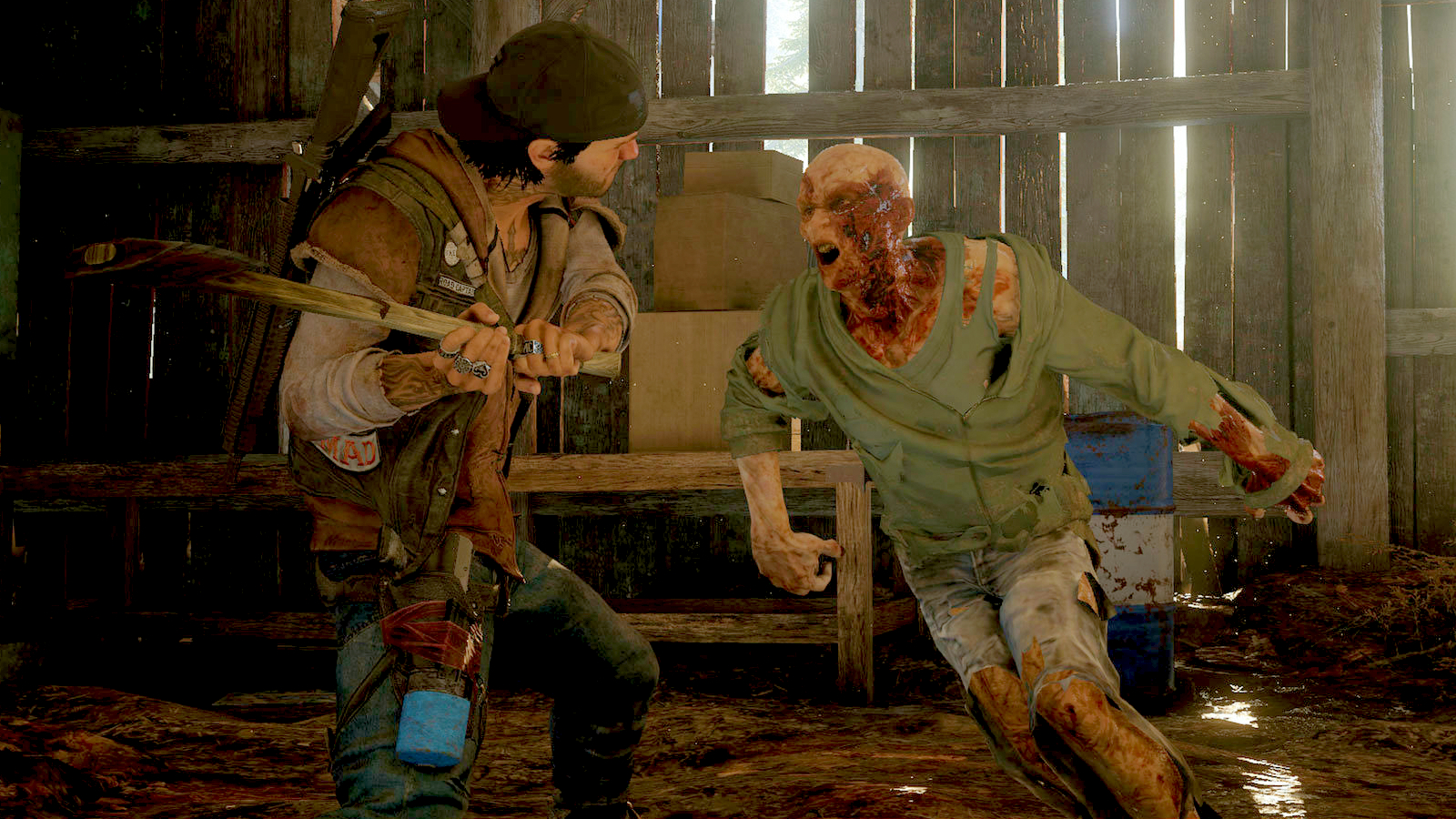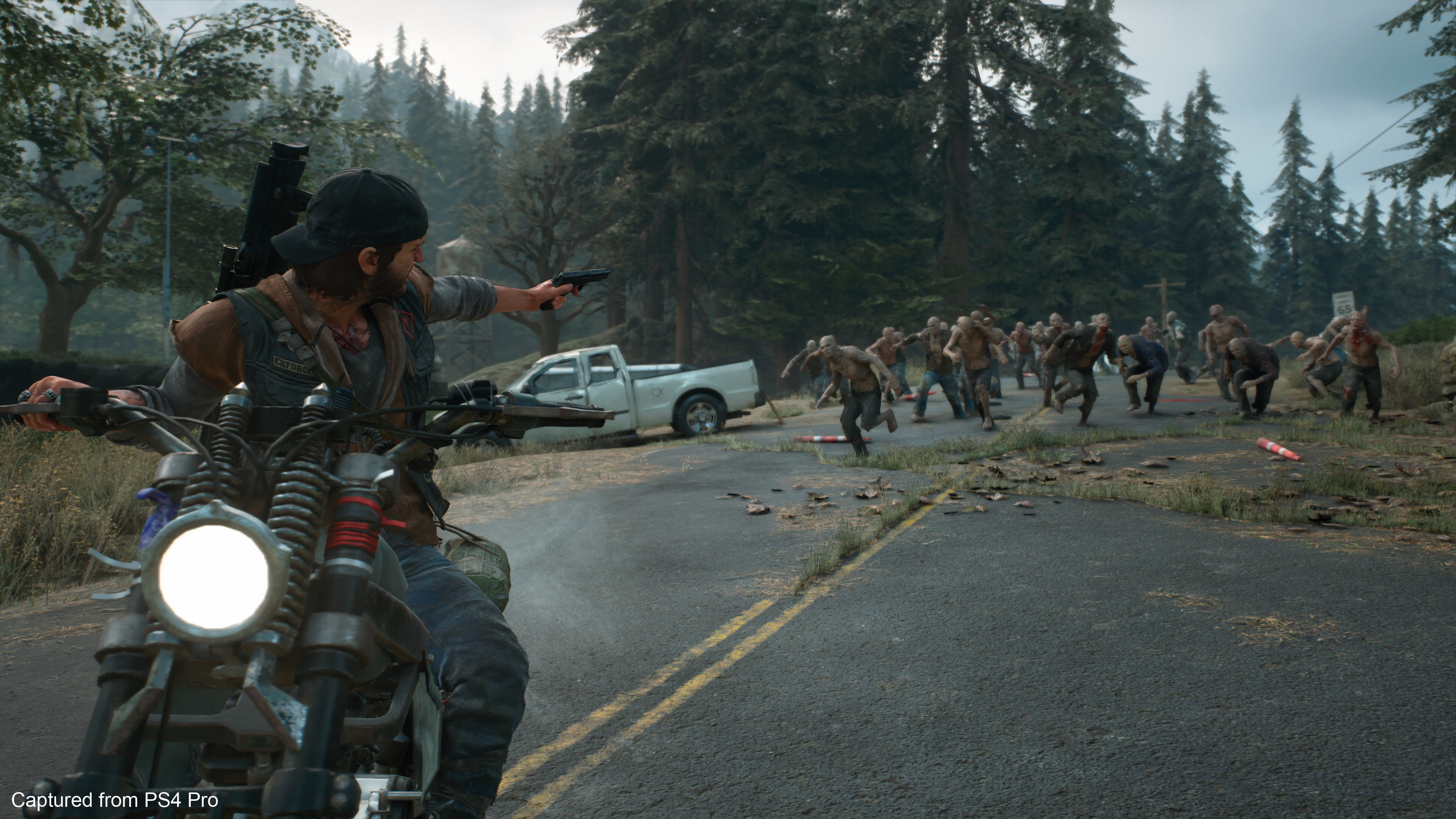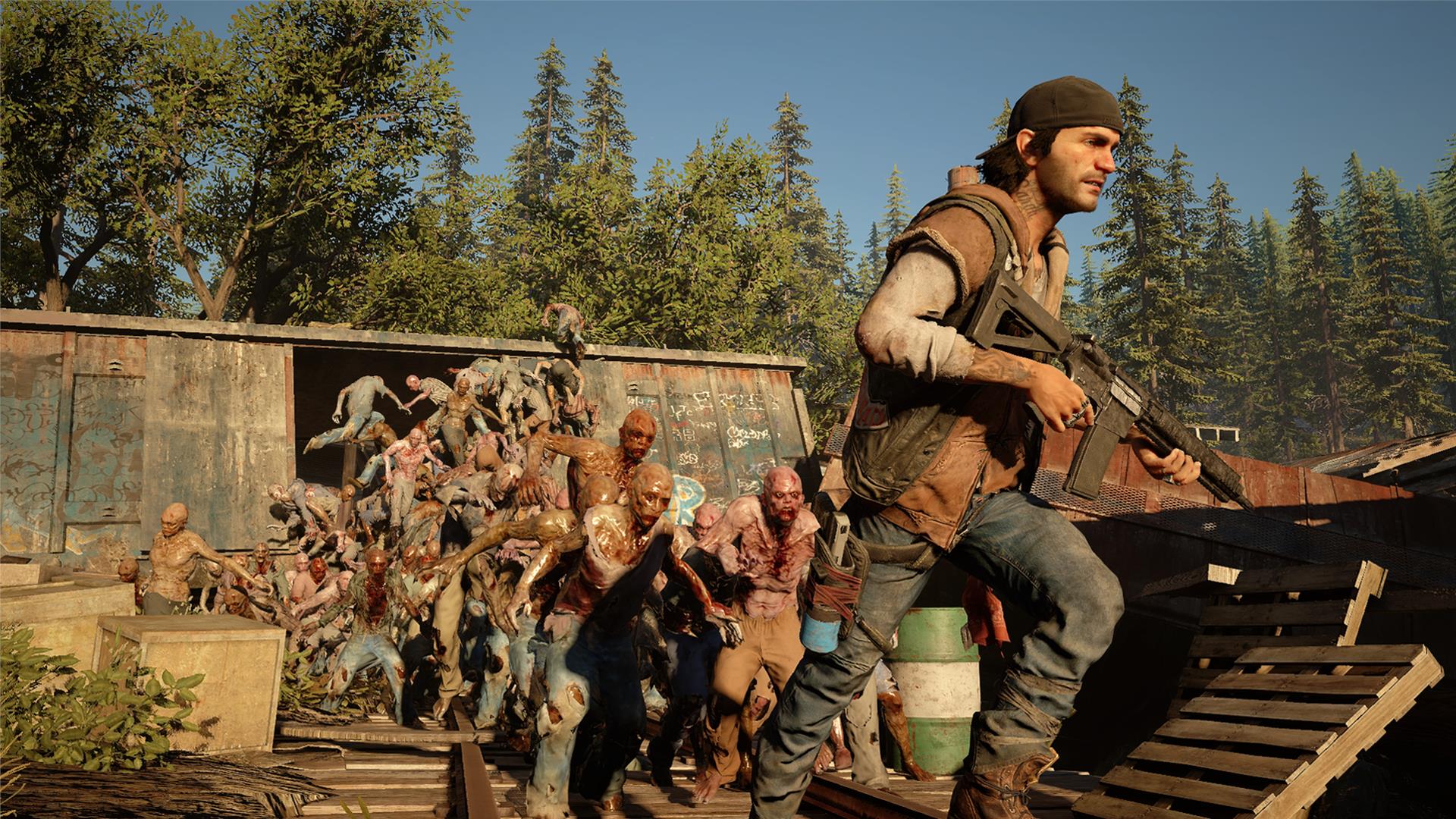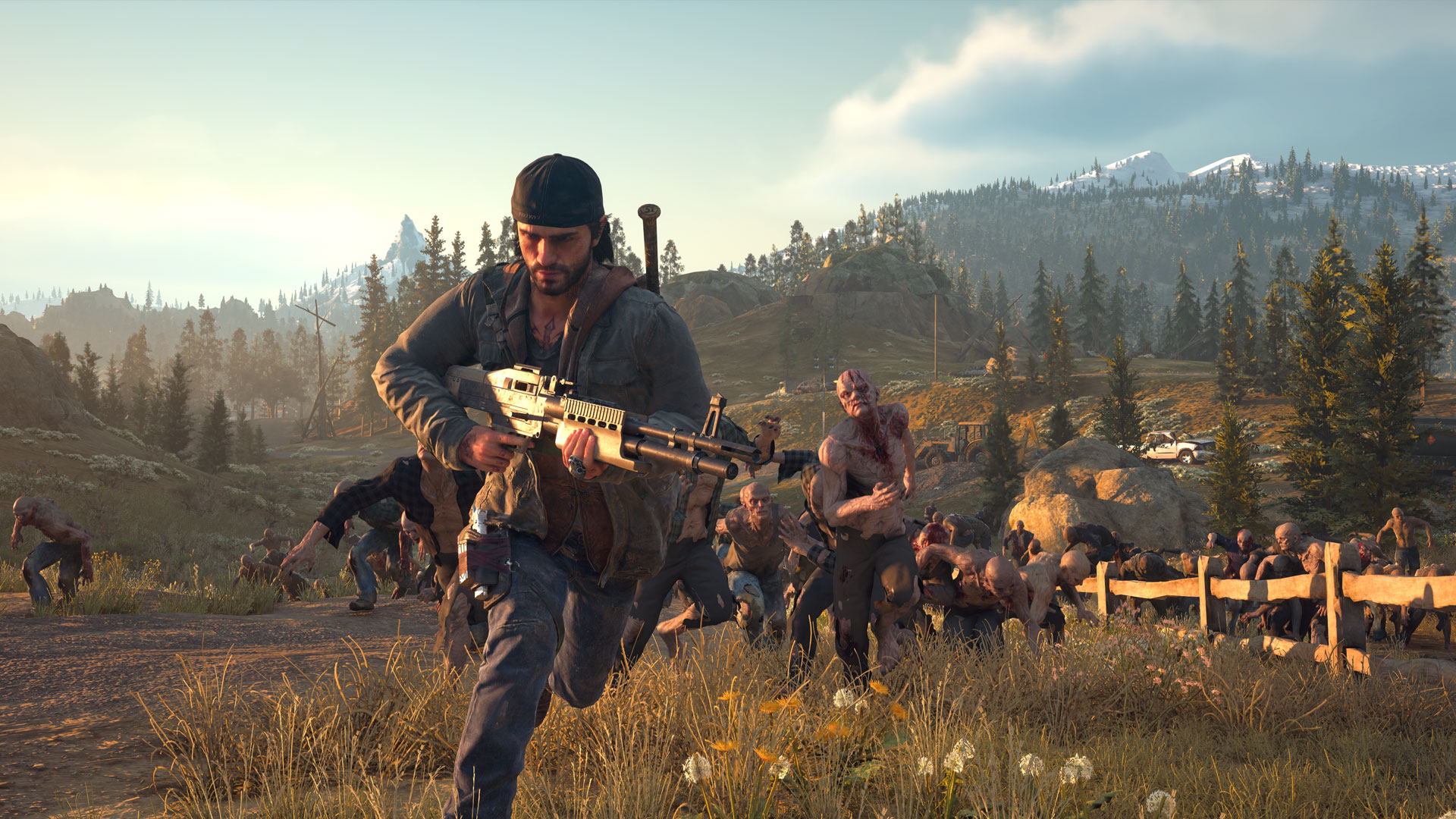GamesRadar+ Verdict
Days Gone is a keen and engaging open world zombie adventure despite some issues.
Pros
- +
Beautiful world
- +
Open ended zombie survival
- +
Hordes are impressive
Cons
- -
Messy story, especially in the opening
- -
Lots of minor bugs
Why you can trust GamesRadar+
I have been on a journey with Days Gone. Both in terms of the hero, Deacon St. John’s, life, and the game itself - a rambling tale of zombie killing in an open world that can easily top 60 hours if you want to see everything. It’s a scrappy but satisfying adventure I’ve enjoyed despite minor bugs and a design that’s obviously been shuffled and cut during its two month delay. There’s a story that’s all over the place, while the game’s key feature - its 100+ strong monster hordes - are an impressive and terrifying spectacle, but not quite the trap-triggering set pieces originally revealed. There are obvious edits, and hot glue seams joining the bits throughout, especially in the first act. But despite that it’s still a big, engaging adventure that’s fun as a whole - enthusiastic and eager to please overall, even if the moment to moment parts don’t always connect smoothly.

Release date: April 26, 2019
Platform(s): PS4
Publisher: Sony
Developer: Sony Bend
First up those bugs. It’s a lot of little things really: nothing unplayable, more grumbling irritations like audio drop outs (silent bikes, say), weird AI moments, animation or collision glitches and framerate drops. For the most part it’s never ruined the experience for me, more chipped away at the polish. Those 60+ hours I’ve played come in part from finishing it (a good 40 odd hours if you’re not rushing) and the rest because I’ve enjoyed it. The post-end game especially. When you’ve unlocked high level skills and weapons it’s a zombie horde-massacring blast. That said, the game’s had four patches before release and I’m not entirely sure what state it’s in, or going to be.
Days Gone review | Days Gone tips | Days Gone map | Days Gone IPCA Tech | Days Gone Horde locations | How to take down a Horde in Days Gone | Days Gone skins | Days Gone secret ending | Days Gone NERO Injector locations | Days Gone Ambush Camp locations | How to store weapons in Days Gone | Days Gone sound bug
Apocal-mix now
Issues aside Days Gone is a hearty if familiar mix of stealthing through enemy camps, combat, upgrades and crafting, mixed with occasional bouts of running the hell away from it’s zombie hordes. This post viral outbreak world is part Assassin’s Creed Odyssey, part Far Cry 5 and part The Last of Us, weaving its mechanics into an experience that is as entertaining as it is, admittedly, unoriginal. There’s a solid progression system as you complete jobs and missions to earn trust with various survivor settlements, unlocking gear, crafting recipes, skills and weapons. That’s the core journey: in-game you progress from a working-to-live drifter, to developing community ties and putting down roots that give you something to fight for. While as a player you change from an opportunistic and cautious survivor to grizzled world beating pro with smarts you’ve earned along the way.

The main monsters aside from people [philosophical chin scratching...] are the Freakers - a mutated (and very alive) human, infected by a rabies-like virus. Early game even a single one is a thing to fear. You don’t have the gear or expertise to really take one on, and just two or three getting your scent is probably game over. As a result, you’ll be creeping cautiously around forests hoping for stealth kills at the start, terrified of every leafy noise in the distance. Later, though, you’ll be tooled up and taking on groups of them, gathered in hundred strong hordes with barely a thought, having learned how they work and how to win. It’s the kind of gradual, satisfying growth that evolves without being obvious until you look back and see how far you’ve come.
Horde games
Even when you’re high level and packing the best gear, hordes are always daunting and terrifying in equal measure. Seeing them scream, as hundreds of clawing, frenzied monsters flow over cars or around buildings like a bucket of grasping hands splashed into the world never gets old. However, they are just sort of scattered around the open map - in caves dotted around the map, or picking at mass graves - with almost no explanation or intent. A few places have a scattering of explosive barrels and trucks to help thin them out, but otherwise it’s generally a case of placing bombs, throwing molotovs and then back peddling and hoping for the best. It’s a far cry from the carefully orchestrated trap-filled, set pieces originally revealed. Only one place - the red barn sawmill of the original 2016 E3 demo - features any of the barriers, doors and traps you can trigger to stem the flow of creatures. Although those are never mentioned or explained, and I set most of them off accidentally wondering why there were prompts hanging in the air. Deacon only even discusses the barest concepts of horde tactics right at the end of the game. By which point I’d learned all I needed to know wondered why I was basically getting a tutorial chat on horde management some 50 hours in.

That sense of things maybe not being in quite the right place also applies to the story. The opening has a strange start with no clear or overriding objective for the first few hours. Instead there’s just a collection of ‘Storylines’ that have you completing jobs for survivor camps. The Storyline system crosses and blends progression so that completing one goal can advance multiple questlines, while some things can stop for no clear reason until you finish doing another job not obviously connected. It is confusing. The very first mission, ‘Chasing Leon’ hangs at 50% for ages even when you have the required item and can wave it frantically in the face of the person who wants it, possible while yelling ‘I have iiiiiit. It’s right here’. To actually complete it you have to finish another mission on the other side of the map, that then unlocks an option to resolve it by making a choice with no clear payoff (despite the claim of making a significant decision). Elsewhere, an event that ultimately drives the first act to completion somehow manages to take barely days but also several weeks at the same time depending on whether you’re measuring by its internal plot time, or by the other required missions that happen in-between. It’s a beginning that feels reconstructed rather than intended, with steps artificially extended by breaks or oddly tiny increments (a couple of mission beats involve little more than a lengthy journey across the map for a single sentence of dialogue).
Plot points
Persist, however, and things coalesce: a new area of the map opens up (and, much later, another area again) and clearer purpose develops. It almost feels like a TV series that doesn’t find its direction until the second season - as you move to new places narrative strands get weighter, better tied together and something more approaching a plot develops. The mid to late game has some likeable, interesting characters and antagonists, and sows enough seeds for some emotional investment to pay off. Although I’d argue it never really settles on an actual ‘main’ goal until almost the final few hours. It also pulls an almost cartoonish and childish fake out with the only high stakes plot choice it makes in the finale. I’m still weirdly angry about it because something that felt irreversible, and meaningful as a result, turns almost into an ‘it was all a dream’ level of joke.
Through all this Deacon is a conflicting character. He’s likeable and funny for the most part as he interacts, quips and wisecracks with the supporting cast. When it works Sam Witwer’s performance has an easy going charm up there with Nolan North or Troy Baker. But the character is also prone to bouts of callous and unrepentant hatred, murderous aggression or outright brutality that can grate against the lighter moments. Largely because the nebulous story structure can see situations switch on a dime, stripping key moments of the momentum needed to back them up, as the emotional makeup of the man changes as if by button press to suit the story. Sometimes it feels like you literally sat on the remote and changed channels accidentally. It’s also worth mentioning that if people struggle accepting Nathan Drake’s actually killed hundreds people, they are going to lose their shit when Deac‘ commits literal war crimes and borderline terrorism. Twice.
The wheel game

There’s another ‘main’ character to consider and that’s the bike, Deacon’s transport through all this. After so many video game horses dutifully following, or coming when called, it takes a little getting used to remembering where you parked, or needing fuel just to move (you also can’t save or fast travel unless you’re near your bike). It’s different, but the motorbike is every bit a tool for you to use, which also grows with you. You upgrade it, decorate it, learn how best to use it and, at this stage, I’m very attached to ‘my’ bike: cherry red, armored grills, flame decals on the gas tank. It helps that Days Gone is a beautiful place to ride through too, with an atmospheric world to take on that rolls on for miles. It’s perfect for long rides - the varied mountains of Oregon evocative in the rain, serene in the snow and exciting as thunder rolls across the sky.
Days Gone’s world is very much greater than the sum of it parts. It’s haphazard nature wouldn’t have survived on a smaller scale, but this is a substantial thing. The story can be spotty, and the gameplay glitchy, but over tens of hours it evens out. It’s easier to forgive a scattered narrative and occasional Freaker standing ankle deep in asphalt when you can spend hours exploring, discovering, or fighting through what it has to offer. It’s open world has enough surprises and depths to penetrate that I always found it enjoyable and full of memorable stories. Like the first time I ran out of fuel (rookie mistake) and crept through the forest at night looking for gas, terrified of every howl and shuffle in the trees. Or the time I discovered a horde by turning my torch on in a cave and finding 50 pale faces staring back at me. Those are the moments that stick with me, despite everything else. This may not hit the heights of recent Sony efforts like God of War or Spider-Man, but it suffers more from that expectation than it does its own rough edges.

I'm GamesRadar's Managing Editor for guides, which means I run GamesRadar's guides and tips content. I also write reviews, previews and features, largely about horror, action adventure, FPS and open world games. I previously worked on Kotaku, and the Official PlayStation Magazine and website.



